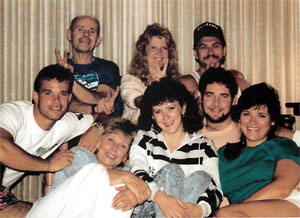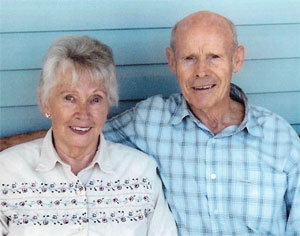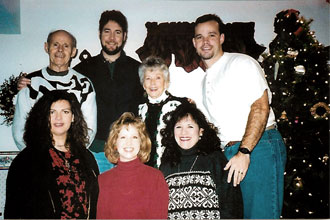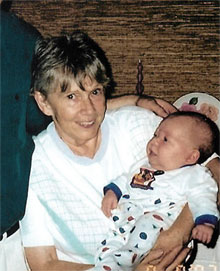Part 3
Life and Death in Assisted Living, Part 3
by A.C. THOMPSON, ProPublica and JONATHAN JONES, special to ProPublica, July 31, 2013
in collaboration with 

On Sept. 30, 2008, an employee at the Emerald Hills assisted living facility in Auburn, Calif., made an entry in a company computer log: “pressure ulcer/wound.”
Joan, who had spent just 19 days in the facility, had developed the wound on her foot. The fall eight days earlier had hospitalized her and left her with bruises and an abrasion on her right temple. This, though, could be much, much worse.
Pressure ulcers — also known as bed sores — can form when a person loses the ability to move about freely. Lying in bed or sitting in a chair for long stretches of time diminishes the blood flow to the skin, causing it to break down and die. A hole grows. If bacteria creep into the wound, the bugs can devour flesh or invade the blood and bones. Pressure ulcers can turn fatal, particularly in older people.
Because of the lethal potential of pressure ulcers, the federal government monitors them closely in the nursing home business. In the eyes of experts, the sores are often an indicator of poor care. Attentive caregivers can prevent many pressure sores by making sure that people don’t spend too much time in the same position.
“We know that most bed sores are avoidable,” said Kathryn Locatell, a forensic geriatrician who investigates allegations of elder abuse for California Department of Justice. “That is the consensus of experts in the field.”
Physicians grade the ulcers on a scale ranging from Stage 1 to Stage 4, with Stage 4 being the most serious. In California, assisted living facilities are allowed to house people with Stage 1 and 2 sores, but only if the resident receives medical treatment from a “skilled professional.” The law bars facilities from renting rooms to people with more severe pressure ulcers.
The Emerald Hills worker who wrote up Joan’s pressure ulcer on Sept. 30 understood its significance. The employee noted that a “skilled professional” would be treating the wound.
Emerald Hills was supposed to contact Joan’s doctor when she developed the ulcer. But nobody from Emerald Hills called a doctor. No nurse came to salve Joan’s wound. And nobody told Joan’s relatives — her husband, Myron, who lived in the same facility, or her son who lived nearby — about the development.
Joan’s short, painful stay at Emerald Hills seemed to be accelerating her decline.
Things had been different at the first assisted living facility Joan had lived at, a place called The Palms near Sacramento. There she’d enjoyed a constant stream of activities. “She was doing things every day,” remembered Eric Boice, her son. There were storytelling sessions, games of wheelchair bowling, arts and crafts. Once Joan had smeared finger paint on her palm and pressed it to a piece of paper, creating a keepsake for her son.
Adequate staff at The Palms was central to the family’s satisfaction with Joan’s stay. Promises that staff would keep Joan active and engaged — central ambitions in dementia care — were kept. And the perils of prolonged inactivity, like mental decline and dangerous sores, were avoided.
By comparison, the unit at Emerald Hills where Joan lived seemed to the family to be poorly staffed and thus static. Staff rarely turned up to organize activities. What few staffers were available managed only to bring Joan down to the TV lounge, where she sat, unengaged. Myron and other family members visited frequently, but otherwise she was marooned.

Melissa Gratiot, the Emeritus salesperson who had convinced the Boices to come to Emerald Hills, had given the family a brochure during her sales pitch. The facility’s “entire staff” would strive to produce “meaningful interactions and activities” for Joan.
But Gratiot had come to doubt her own marketing pitch, and a lack of staff was part of what colored her regret. She saw few activities going on in the memory care unit and rarely saw her colleagues working to protect Joan from long stays in her wheelchair or bed.
“When I would see Joan,” Gratiot said, “she'd be in the TV room, sitting in a chair.”
“State Visits, Fines, Resident Upheaval”
Just months before Joan arrived at Emerald Hills, Mary Kasuba, a nurse there, told senior management at Emeritus that things needed to change. She took her concerns directly to the top bosses, the executives in Seattle who ran the assisted living empire from a gleaming glass office cube on the Puget Sound.
In late 2007, Kasuba wrote a five-page letter and sent it via certified mail to the 10 highest-ranking figures in the company. In the letter, Kasuba warned of “total dysfunction” at Emerald Hills because of “the way the corporation mandates this building to be run.”
She pleaded for the bare essentials any assisted living facility needed to operate safely: a key one being an adequate workforce.
Alarms bells had been ringing in Kasuba’s head nonstop during her short tenure at Emerald Hills. The first was triggered when she had to cover the overnight shift with another employee. There were roughly 80 seniors living at Emerald Hills at the time.
“There were residents that could not necessarily get up and walk to the bathroom on their own,” Kasuba said in an interview.
Some of them, she immediately noticed, needed the help of two people — all the workers she had on duty — to get out of bed and shuffle to the toilet. If any sort of emergency had forced Kasuba to evacuate the building, it would have been slow-motion chaos.
Typically, Kasuba would grab a nap as dawn broke and be back at Emerald Hills by 10 a.m. The scene wasn’t much better on the day shift. She came to feel the company was exploiting its customers.
In her letter to Emeritus officials, she wrote, “Since I came to work with Emerald Hills, there has not been enough staff to cover any part of the day-to-day staffing needs.”
Kasuba’s biggest worry was the medication room. The medication technicians, called “med techs” in the industry, were responsible for passing out a mountain of pills each shift. Med techs aren’t nurses or even certified nursing assistants. Typically, they have no formal medical education. At Emerald Hills at that time they made approximately $8 to $10 an hour.
One medication technician, Kasuba wrote, “was placed in the med room with maybe a day’s training. She worked in the med room until her stress level became such that she stepped down.”
Recordkeeping throughout the facility was haphazard at best. Documents were missing or misfiled. One resident’s chart, according to the nurse, contained a doctor’s evaluation that had been filled out and signed by a family member — not an MD.
Again, Kasuba didn’t mince words, calling the medication operation “a sinking ship with no ballast compartments to keep it afloat.”
Kasuba ended her letter to the company’s executives with an ultimatum: Let her make major changes at Emerald Hills or she was out.
“Corporate can hire someone else and the cycle of dysfunction will begin again,” she wrote. “State visits, fines, resident upheaval, staff turnover.”
Emeritus replaced Kasuba. The company says it dealt with the concerns she raised about Emerald Hills. Many of those who remained at Emerald Hills tell a different story.

A couple of years later, Susan Rotella got a taste of the same problems, but on a much grander scale. In November 2009, Emeritus tapped Rotella, who had made her career in assisted living, to manage the company’s California division. It was a big job. Emeritus agreed to pay her $210,000 per year, plus bonuses and stock options. She’d be part of a three-person executive team overseeing 45 facilities.
Rotella testified under oath that as she traveled around the state meeting Emeritus employees she heard one thing over and over: The facilities needed more staff.
The division, however, wasn’t posting the kind of financial numbers Emeritus wanted to see.
“All eyes were on California because we were keeping the stock price down,” she said. “As California went, so went Emeritus.”
One man didn’t bother to sugarcoat his feelings about the California division, Rotella said. As she tells it, shortly after signing on with Emeritus, she was welcomed aboard by company founder Daniel Baty.
Baty, she recalled, said, “Ah, so you’re the one who is going to run the shithole.”
He denies making the statement.
Rotella’s superiors directed her to slash labor costs by 10 percent across the board, she said. Facility directors “were constantly being told to cut labor expense, cut labor, cut labor, cut labor,” she added.
Emeritus said Rotella’s claims were false. “Unfortunately, it is another accusation without any documentation, evidence, or even another person present to verify the conversation. Emeritus would not enact across-the-board labor cuts at the expense of our residents’ care needs,” the company said in a statement.
The assisted living industry is overseen in a very different manner from its closest cousin, the nursing home business. Nursing homes are governed by a complex grid of federal and state regulations. The U.S. Centers for Medicare & Medicaid Services collect a vast array of data from nursing homes — drug prescribing patterns, staffing levels, patients who’ve had falls, etc. — and make much of it available to the public through a website called Nursing Home Compare. And an array of information on fines and inspections can be found on the easier-to-use website Nursing Home Inspect. States set minimum staffing requirements for nursing homes.
The early advocates of the assisted living movement chafed at many of these regulatory dictates. They wanted flexibility, the ability to innovate. They wanted to create spaces that were more home, less hospital. Today, two decades on, there are still no federal standards and leaders of this growing business sector continue to push back against anything more than modest government oversight.
Their success at staving off uniform regulation from state to state means Emeritus’s hundreds of facilities operate under wildly varying regulations and offer different services. From Miami to Dallas to Des Moines, there isn’t even an agreed-upon definition of assisted living.
“We say in this business if you’ve seen one assisted living community, you’ve seen one assisted living community,” said Rick Grimes, president of the Assisted Living Federation of America, a trade group.
The dearth of hard and fast rules gives executives and managers at assisted living companies wide latitude in deciding how many workers should be clocking in on a given shift. Many states require assisted living facilities to keep “sufficient” staff on duty at all times, but don’t define what that means.
The increasing frailty of the population in assisted living makes adequate staffing critical to quality of care, said Catherine Hawes, a Texas A&M professor and an expert on the assisted living industry. According to a 2010 national survey, more than 50 percent of assisted living residents need help dressing and bathing and 42 percent have some form of dementia.
Publicly traded companies like Emeritus are under substantial pressure to hit their financial goals — each quarterly performance is scrutinized and failing to meet expectations can damage the company’s value.
To hit their goals, then, Emeritus tightly manages its workforce. “Tightly manages” often means reducing staff, slashing wages and curtailing benefits.
Chief executive Granger Cobb addressed the issue with investors and market analysts as recently as last year.
“We're feeling good about the cost structure,” he said. “I think we’ve got a very good control on the — our biggest expense, which is labor. We’re managing it very closely.”
Emeritus had just cut its overhead by 8.2 percent, largely by cutting pay and benefits.
The company asserts that all of its facilities are adequately staffed, and that it would never compromise care by irresponsibly reducing staff.
One former Emeritus executive, who supervised nurses in multiple states for a period of years, thought the company kept its staffing levels dangerously low as a matter of policy.
“Is that unique to Emeritus? I would say it’s ubiquitous to the entire assisted living industry,” said the executive. “We need to take a huge step back and look at this whole industry.”
Lack of proper supervision at Emeritus facilities appears to have played a central role in several cases in which residents suffered avoidable and sometimes catastrophic harm.
- On Christmas Day 2004, Mabel Austin froze to death in front of an Emeritus facility in Texas. The lone staffer on duty in the memory care unit didn’t realize that Austin, 91 years old and suffering from Alzheimer’s, had walked out of the building. Emeritus would not comment on this case.
- It took about 12 hours for staffers at an Emeritus facility in Iowa to call an ambulance after 84-year-old Paulyne Stevens took a fall in her bedroom. An employee at the facility put Stevens back in her bed, but did not contact any medical professionals. When doctors finally examined Stevens they found she had six broken ribs and a deflated lung. Investigators found workers at the facility didn’t have legally required training. Emeritus admits the incident was mishandled, and has settled a lawsuit with the family.
- June Hassler, 86, died in a locked bathroom at an Emeritus facility in Pennsylvania. It took employees 36 hours to notice. The director of the facility said the staff thought Hassler was visiting family. Two years earlier, 84-year-old Eleanor Hodges died in the same facility after being attacked by a male resident with a history of aggressive behavior. The state found that Emeritus had failed “to provide proper supervision” of the man. Emeritus told the state it would act to correct the problems that led to Hodges’s death. Hodge’s family has sued Emeritus.
Emeritus portrays incidents such as these as isolated events and says state authorities are citing the company less and less frequently for violations. “If you look at our regulatory history versus others in the industry we probably fare pretty well,” Cobb said.
There are no national statistics on regulatory violations in assisted living. But ProPublica and Frontline obtained and analyzed data from California, the state with the most assisted living facilities. The data – compiled by the state ombudsman program, which investigates allegations of abuse and misconduct – shows that between 2010 and 2012, Emeritus had more verified complaints per bed than any of its major competitors. In two of those years, the company had more substantiated neglect complaints than the other big chains, again on a per bed basis.
Some companies have devised their own systems for calculating how many people should be on duty on any given shift. Though Emeritus collects and parses a vast array of data, much of it focused on sales and profitability, it has chosen not to create a staffing ratio or formula.
This surprised Rotella, the California executive. She had previously worked at another major chain called Sunrise Senior Living, which had used a formula based on the health needs of each resident.
Rotella said she brought the issue up at a meeting with the man in charge of quality control for the entire Emeritus empire, a nurse named Budgie Amparo.
“He stood up and he was quite agitated. And he said, ‘We will never have staffing ratios at Emeritus,’” Rotella recalled. Amparo said that if somebody got hurt or killed in an Emeritus facility, a written ratio or formula could be a liability, according to Rotella. If it turned out the company wasn’t following its own staffing protocol, the plaintiff lawyers would jump all over them.
“I don’t remember that,” Amparo said. In a statement, Emeritus said “we do not have a staffing formula” because such a formula “would not serve our residents’ best interests.”

Emeritus ousted Rotella shortly after her conversation with Amparo. It was March 2010 and she had been on the job for three months. Today she works as a consultant to assisted living firms and is suing Emeritus for wrongful termination. Company leaders, Rotella said, viewed her as a “troublemaker.”
When Joan Boice took up residence at Emerald Hills in the autumn of 2008, the lack of staff was evident.
The facilitydidn’t assignany workersto the memory care uniton five nights, according to company time sheets.
Emeritus says the employees filled every shift in the memory care unit; they just didn’t keep accurate records of their labor.
Workers in the building felt overwhelmed and bitter. As discontent mounted, the facility director ordered employees not to share their complaints with the public.
“They do not need to know you are tired,” the director wrote in a memo. “They are NOT to hear we are short staffed.”
Then Emeritus decided to shrink the payroll even further. The facility reduced the number of med techs. That meant there would only be one such employee on duty during the facility’s busiest shifts.
Jenny Hitt was one of the med techs affected by the downsizing. Hitt had to keep track of “thousands” of pills coming into the building from a host of different pharmacies. Some residents were taking “15 different prescriptions” and needed to receive pills up to six times per day. Hitt, who didn’t complete high school and had no medical education, said she was so busy that she sometimes had to “run down the hallways” to get all of her rounds done.
The company, she said, often assigned her to double shifts and once kept her on duty for 24 hours straight.
After Hitt made multiple calls to the company’s “Ethics First” hotline — a supposedly anonymous in-house reporting tool — Emeritus fired her. Her boss told her she had made a medication mistake. She says she was fired because she was calling attention to the building’s failings.
Out of a job, Hitt said she felt only relief. She was weary of worrying that she might kill someone.
Language Had Left Her

In Room 101, Joan’s room, the ulcer on her foot worsened. One day slid into the next. An Emeritus employee faxed a message to Joan’s physician: Joan “seems to be experiencing more frequent and intense pain…She has trouble putting weight on her right foot…Please advise.”
It was Oct. 14 — a full two weeks after the Emeritus worker had first noted the wound in her records.
The physician promptly faxed back instructions: Bring her in for X-rays of her right foot and ankle. But nobody at Emerald Hills told the family about the doctor’s order.
It would be three more weeks before the facility finally informed the Boice family about Joan’s damaged foot. An Emeritus worker phoned Kathleen Boice, Joan’s daughter-in-law, who lived nearby, on Nov. 3. Blood, the employee said, was seeping through Joan’s sock.
Eric Boice took his mother to the doctor on Nov. 4. The doctor’s notes show that the physician thought the wound might have been an ulcerated bunion; the physician, Tayyiba Awan, wondered whether Joan had been lying on her side for long periods of time. The wound had scabbed over and seemed to be healing. Awan did not examine the rest of Joan’s body for sores.
But Joan had other issues, the doctor noted. She’d lost much of her ability to move the right side of her body. The doctor wondered whether she had suffered a series of minor strokes. And so she ordered physical therapists to visit Joan at Emerald Hills to try and improve her mobility.
Back at Emerald Hills, Myron came to Joan’s room frequently, often bringing snacks. Eric Boice would visit his mother one day; the next, Kathleen would visit. They divided the labor, and the heartache.
Over the weeks, Kathleen came to think something was “weird.” But she couldn’t figure out what was going on with Joan. And Joan couldn’t say what was wrong. Language had left her.
“You know, most of the time she was in a bed. Blanket sheets up on her,” Eric recalled. “You know, I sat with my mom, I held her hand and I spoke to her.”
He told her what the grandkids were doing. He’d inform her if his son had played a baseball game the day before.
Disease had transformed his mother. It had spun their roles around. But in Room 101, Eric couldn’t always bring himself to treat his mother like a child. He just never felt comfortable asking her to undress so he could examine her.
If Eric had seen her skin he might have understood what was going on. There wasn’t just a single wound. The pressure ulcers were marching across her body.
Correction (8/1): An earlier version of this story mistakenly stated that June Hassler’s relatives sued Emeritus. They did not.


